Strategies for Developing Inclusive Teaching, Learning, and Assessment
VerifiedAdded on 2023/01/12
|18
|5571
|2
Report
AI Summary
This report analyzes the development of inclusive teaching, learning, and assessment practices. It begins by exploring pedagogical principles, including Piaget and Bruner's theories, and their application in educational settings. The report then examines how minimum core elements like literacy, language, numeracy, and ICT skills can be demonstrated in planning and delivering inclusive teaching. It evaluates the effectiveness of creative and innovative teaching approaches and explains how the author's practice incorporates learning, communication, and assessment theories. Furthermore, the report delves into behavior management theories, particularly Maslow's hierarchy of needs, and discusses how to create and maintain a safe and inclusive learning environment. It includes evidence of using diagnostic assessments, devising a scheme of work, and designing resources that promote equality and value diversity. The report also covers communication strategies with learners and professionals and concludes with an evaluation of the author's practice, identifying areas for improvement in planning, delivery, and assessment within an inclusive framework.
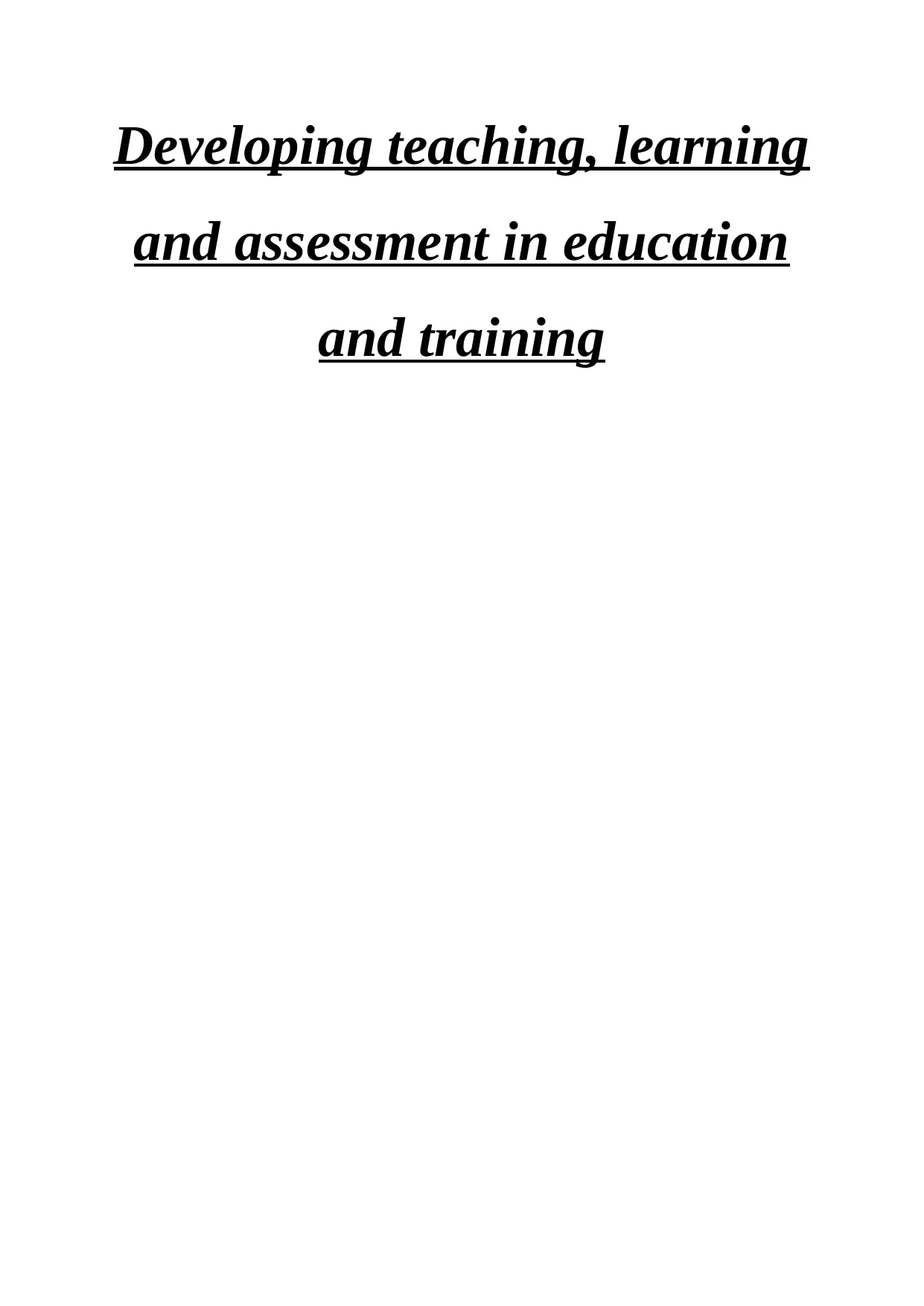
Developing teaching, learning
and assessment in education
and training
and assessment in education
and training
Paraphrase This Document
Need a fresh take? Get an instant paraphrase of this document with our AI Paraphraser
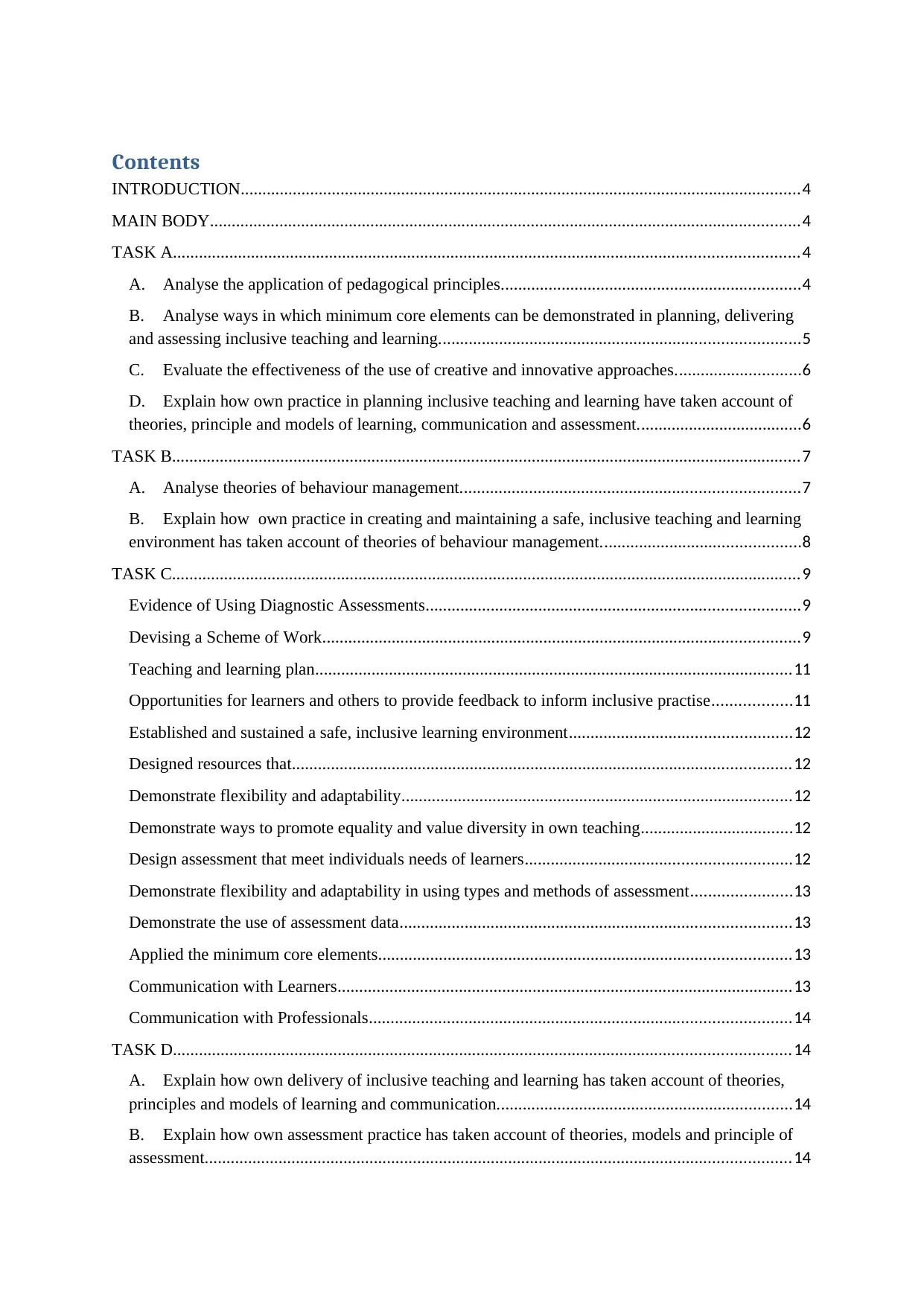
Contents
INTRODUCTION.................................................................................................................................4
MAIN BODY........................................................................................................................................4
TASK A................................................................................................................................................4
A. Analyse the application of pedagogical principles.....................................................................4
B. Analyse ways in which minimum core elements can be demonstrated in planning, delivering
and assessing inclusive teaching and learning...................................................................................5
C. Evaluate the effectiveness of the use of creative and innovative approaches.............................6
D. Explain how own practice in planning inclusive teaching and learning have taken account of
theories, principle and models of learning, communication and assessment......................................6
TASK B.................................................................................................................................................7
A. Analyse theories of behaviour management..............................................................................7
B. Explain how own practice in creating and maintaining a safe, inclusive teaching and learning
environment has taken account of theories of behaviour management..............................................8
TASK C.................................................................................................................................................9
Evidence of Using Diagnostic Assessments......................................................................................9
Devising a Scheme of Work..............................................................................................................9
Teaching and learning plan..............................................................................................................11
Opportunities for learners and others to provide feedback to inform inclusive practise..................11
Established and sustained a safe, inclusive learning environment...................................................12
Designed resources that...................................................................................................................12
Demonstrate flexibility and adaptability..........................................................................................12
Demonstrate ways to promote equality and value diversity in own teaching...................................12
Design assessment that meet individuals needs of learners.............................................................12
Demonstrate flexibility and adaptability in using types and methods of assessment.......................13
Demonstrate the use of assessment data..........................................................................................13
Applied the minimum core elements...............................................................................................13
Communication with Learners.........................................................................................................13
Communication with Professionals.................................................................................................14
TASK D..............................................................................................................................................14
A. Explain how own delivery of inclusive teaching and learning has taken account of theories,
principles and models of learning and communication....................................................................14
B. Explain how own assessment practice has taken account of theories, models and principle of
assessment.......................................................................................................................................14
INTRODUCTION.................................................................................................................................4
MAIN BODY........................................................................................................................................4
TASK A................................................................................................................................................4
A. Analyse the application of pedagogical principles.....................................................................4
B. Analyse ways in which minimum core elements can be demonstrated in planning, delivering
and assessing inclusive teaching and learning...................................................................................5
C. Evaluate the effectiveness of the use of creative and innovative approaches.............................6
D. Explain how own practice in planning inclusive teaching and learning have taken account of
theories, principle and models of learning, communication and assessment......................................6
TASK B.................................................................................................................................................7
A. Analyse theories of behaviour management..............................................................................7
B. Explain how own practice in creating and maintaining a safe, inclusive teaching and learning
environment has taken account of theories of behaviour management..............................................8
TASK C.................................................................................................................................................9
Evidence of Using Diagnostic Assessments......................................................................................9
Devising a Scheme of Work..............................................................................................................9
Teaching and learning plan..............................................................................................................11
Opportunities for learners and others to provide feedback to inform inclusive practise..................11
Established and sustained a safe, inclusive learning environment...................................................12
Designed resources that...................................................................................................................12
Demonstrate flexibility and adaptability..........................................................................................12
Demonstrate ways to promote equality and value diversity in own teaching...................................12
Design assessment that meet individuals needs of learners.............................................................12
Demonstrate flexibility and adaptability in using types and methods of assessment.......................13
Demonstrate the use of assessment data..........................................................................................13
Applied the minimum core elements...............................................................................................13
Communication with Learners.........................................................................................................13
Communication with Professionals.................................................................................................14
TASK D..............................................................................................................................................14
A. Explain how own delivery of inclusive teaching and learning has taken account of theories,
principles and models of learning and communication....................................................................14
B. Explain how own assessment practice has taken account of theories, models and principle of
assessment.......................................................................................................................................14
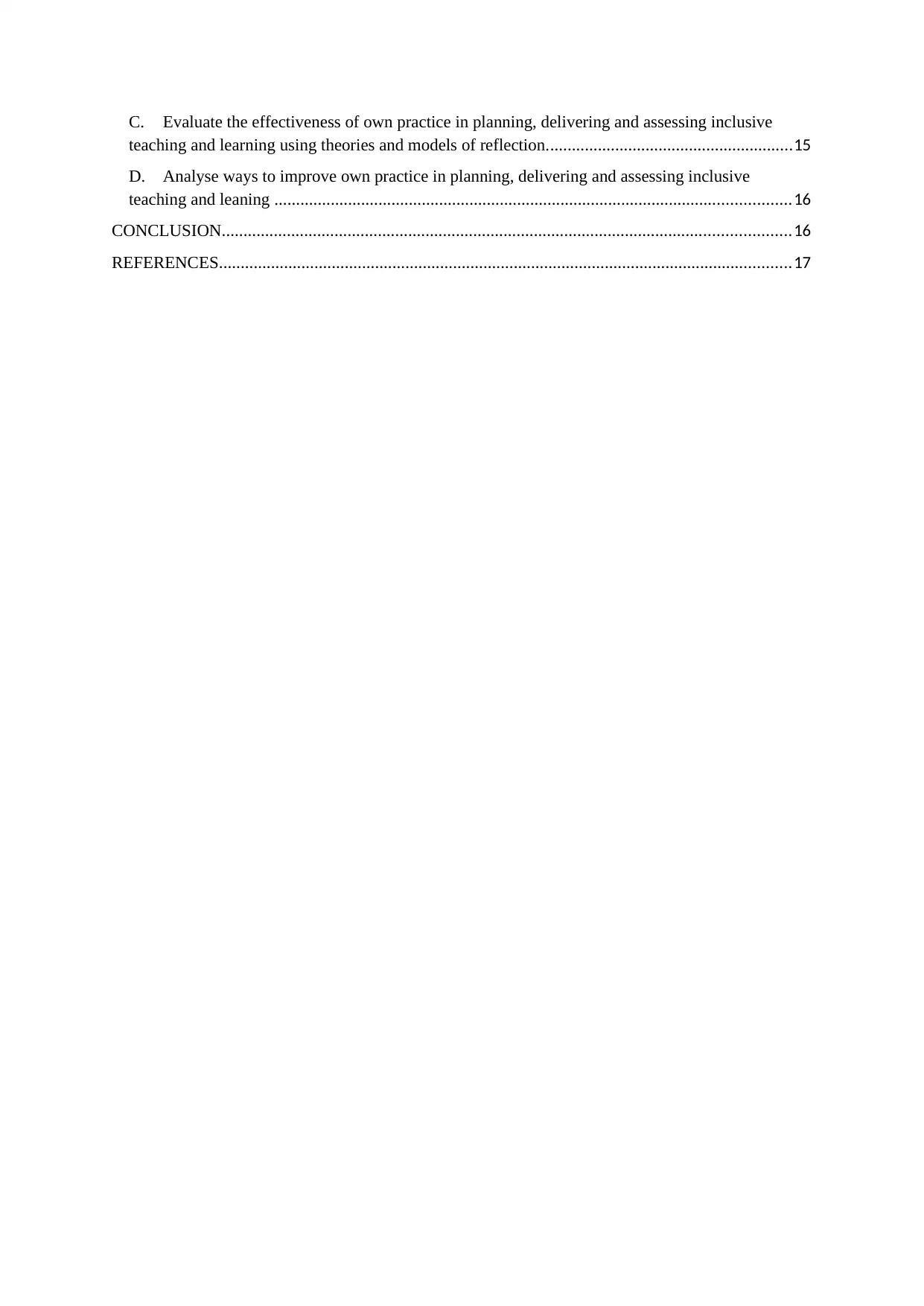
C. Evaluate the effectiveness of own practice in planning, delivering and assessing inclusive
teaching and learning using theories and models of reflection.........................................................15
D. Analyse ways to improve own practice in planning, delivering and assessing inclusive
teaching and leaning .......................................................................................................................16
CONCLUSION...................................................................................................................................16
REFERENCES....................................................................................................................................17
teaching and learning using theories and models of reflection.........................................................15
D. Analyse ways to improve own practice in planning, delivering and assessing inclusive
teaching and leaning .......................................................................................................................16
CONCLUSION...................................................................................................................................16
REFERENCES....................................................................................................................................17
⊘ This is a preview!⊘
Do you want full access?
Subscribe today to unlock all pages.

Trusted by 1+ million students worldwide
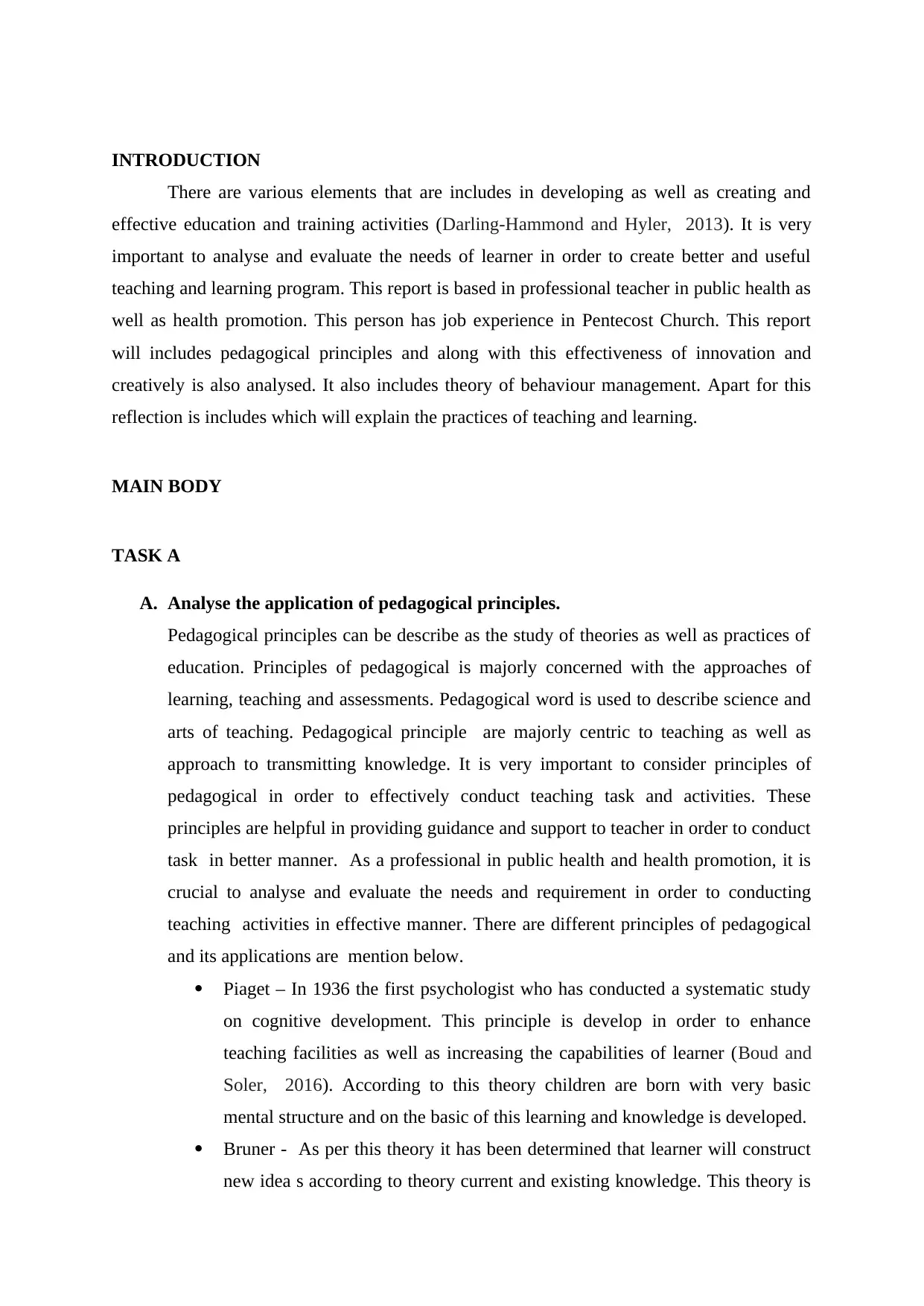
INTRODUCTION
There are various elements that are includes in developing as well as creating and
effective education and training activities (Darling-Hammond and Hyler, 2013). It is very
important to analyse and evaluate the needs of learner in order to create better and useful
teaching and learning program. This report is based in professional teacher in public health as
well as health promotion. This person has job experience in Pentecost Church. This report
will includes pedagogical principles and along with this effectiveness of innovation and
creatively is also analysed. It also includes theory of behaviour management. Apart for this
reflection is includes which will explain the practices of teaching and learning.
MAIN BODY
TASK A
A. Analyse the application of pedagogical principles.
Pedagogical principles can be describe as the study of theories as well as practices of
education. Principles of pedagogical is majorly concerned with the approaches of
learning, teaching and assessments. Pedagogical word is used to describe science and
arts of teaching. Pedagogical principle are majorly centric to teaching as well as
approach to transmitting knowledge. It is very important to consider principles of
pedagogical in order to effectively conduct teaching task and activities. These
principles are helpful in providing guidance and support to teacher in order to conduct
task in better manner. As a professional in public health and health promotion, it is
crucial to analyse and evaluate the needs and requirement in order to conducting
teaching activities in effective manner. There are different principles of pedagogical
and its applications are mention below.
Piaget – In 1936 the first psychologist who has conducted a systematic study
on cognitive development. This principle is develop in order to enhance
teaching facilities as well as increasing the capabilities of learner (Boud and
Soler, 2016). According to this theory children are born with very basic
mental structure and on the basic of this learning and knowledge is developed.
Bruner - As per this theory it has been determined that learner will construct
new idea s according to theory current and existing knowledge. This theory is
There are various elements that are includes in developing as well as creating and
effective education and training activities (Darling-Hammond and Hyler, 2013). It is very
important to analyse and evaluate the needs of learner in order to create better and useful
teaching and learning program. This report is based in professional teacher in public health as
well as health promotion. This person has job experience in Pentecost Church. This report
will includes pedagogical principles and along with this effectiveness of innovation and
creatively is also analysed. It also includes theory of behaviour management. Apart for this
reflection is includes which will explain the practices of teaching and learning.
MAIN BODY
TASK A
A. Analyse the application of pedagogical principles.
Pedagogical principles can be describe as the study of theories as well as practices of
education. Principles of pedagogical is majorly concerned with the approaches of
learning, teaching and assessments. Pedagogical word is used to describe science and
arts of teaching. Pedagogical principle are majorly centric to teaching as well as
approach to transmitting knowledge. It is very important to consider principles of
pedagogical in order to effectively conduct teaching task and activities. These
principles are helpful in providing guidance and support to teacher in order to conduct
task in better manner. As a professional in public health and health promotion, it is
crucial to analyse and evaluate the needs and requirement in order to conducting
teaching activities in effective manner. There are different principles of pedagogical
and its applications are mention below.
Piaget – In 1936 the first psychologist who has conducted a systematic study
on cognitive development. This principle is develop in order to enhance
teaching facilities as well as increasing the capabilities of learner (Boud and
Soler, 2016). According to this theory children are born with very basic
mental structure and on the basic of this learning and knowledge is developed.
Bruner - As per this theory it has been determined that learner will construct
new idea s according to theory current and existing knowledge. This theory is
Paraphrase This Document
Need a fresh take? Get an instant paraphrase of this document with our AI Paraphraser
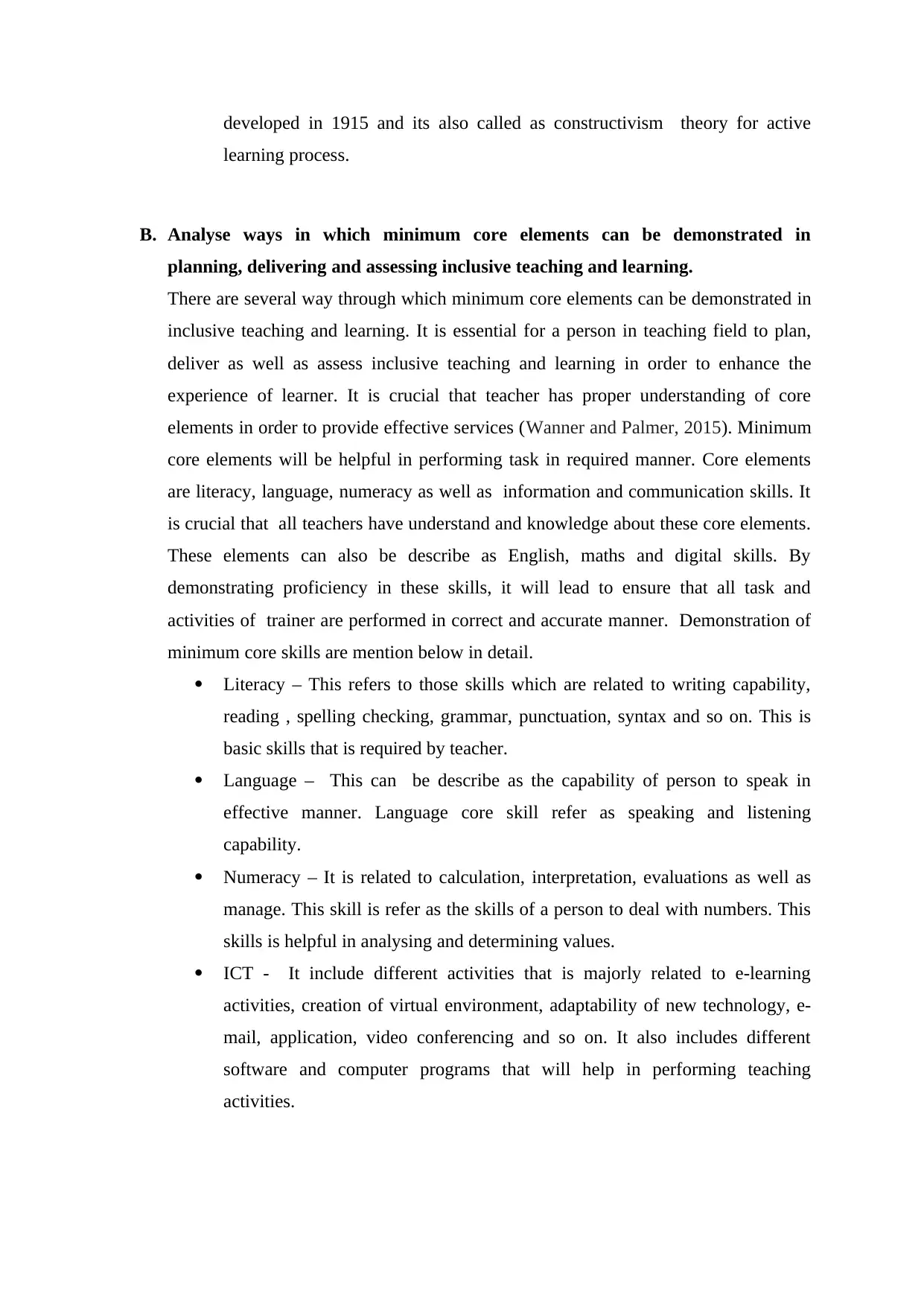
developed in 1915 and its also called as constructivism theory for active
learning process.
B. Analyse ways in which minimum core elements can be demonstrated in
planning, delivering and assessing inclusive teaching and learning.
There are several way through which minimum core elements can be demonstrated in
inclusive teaching and learning. It is essential for a person in teaching field to plan,
deliver as well as assess inclusive teaching and learning in order to enhance the
experience of learner. It is crucial that teacher has proper understanding of core
elements in order to provide effective services (Wanner and Palmer, 2015). Minimum
core elements will be helpful in performing task in required manner. Core elements
are literacy, language, numeracy as well as information and communication skills. It
is crucial that all teachers have understand and knowledge about these core elements.
These elements can also be describe as English, maths and digital skills. By
demonstrating proficiency in these skills, it will lead to ensure that all task and
activities of trainer are performed in correct and accurate manner. Demonstration of
minimum core skills are mention below in detail.
Literacy – This refers to those skills which are related to writing capability,
reading , spelling checking, grammar, punctuation, syntax and so on. This is
basic skills that is required by teacher.
Language – This can be describe as the capability of person to speak in
effective manner. Language core skill refer as speaking and listening
capability.
Numeracy – It is related to calculation, interpretation, evaluations as well as
manage. This skill is refer as the skills of a person to deal with numbers. This
skills is helpful in analysing and determining values.
ICT - It include different activities that is majorly related to e-learning
activities, creation of virtual environment, adaptability of new technology, e-
mail, application, video conferencing and so on. It also includes different
software and computer programs that will help in performing teaching
activities.
learning process.
B. Analyse ways in which minimum core elements can be demonstrated in
planning, delivering and assessing inclusive teaching and learning.
There are several way through which minimum core elements can be demonstrated in
inclusive teaching and learning. It is essential for a person in teaching field to plan,
deliver as well as assess inclusive teaching and learning in order to enhance the
experience of learner. It is crucial that teacher has proper understanding of core
elements in order to provide effective services (Wanner and Palmer, 2015). Minimum
core elements will be helpful in performing task in required manner. Core elements
are literacy, language, numeracy as well as information and communication skills. It
is crucial that all teachers have understand and knowledge about these core elements.
These elements can also be describe as English, maths and digital skills. By
demonstrating proficiency in these skills, it will lead to ensure that all task and
activities of trainer are performed in correct and accurate manner. Demonstration of
minimum core skills are mention below in detail.
Literacy – This refers to those skills which are related to writing capability,
reading , spelling checking, grammar, punctuation, syntax and so on. This is
basic skills that is required by teacher.
Language – This can be describe as the capability of person to speak in
effective manner. Language core skill refer as speaking and listening
capability.
Numeracy – It is related to calculation, interpretation, evaluations as well as
manage. This skill is refer as the skills of a person to deal with numbers. This
skills is helpful in analysing and determining values.
ICT - It include different activities that is majorly related to e-learning
activities, creation of virtual environment, adaptability of new technology, e-
mail, application, video conferencing and so on. It also includes different
software and computer programs that will help in performing teaching
activities.
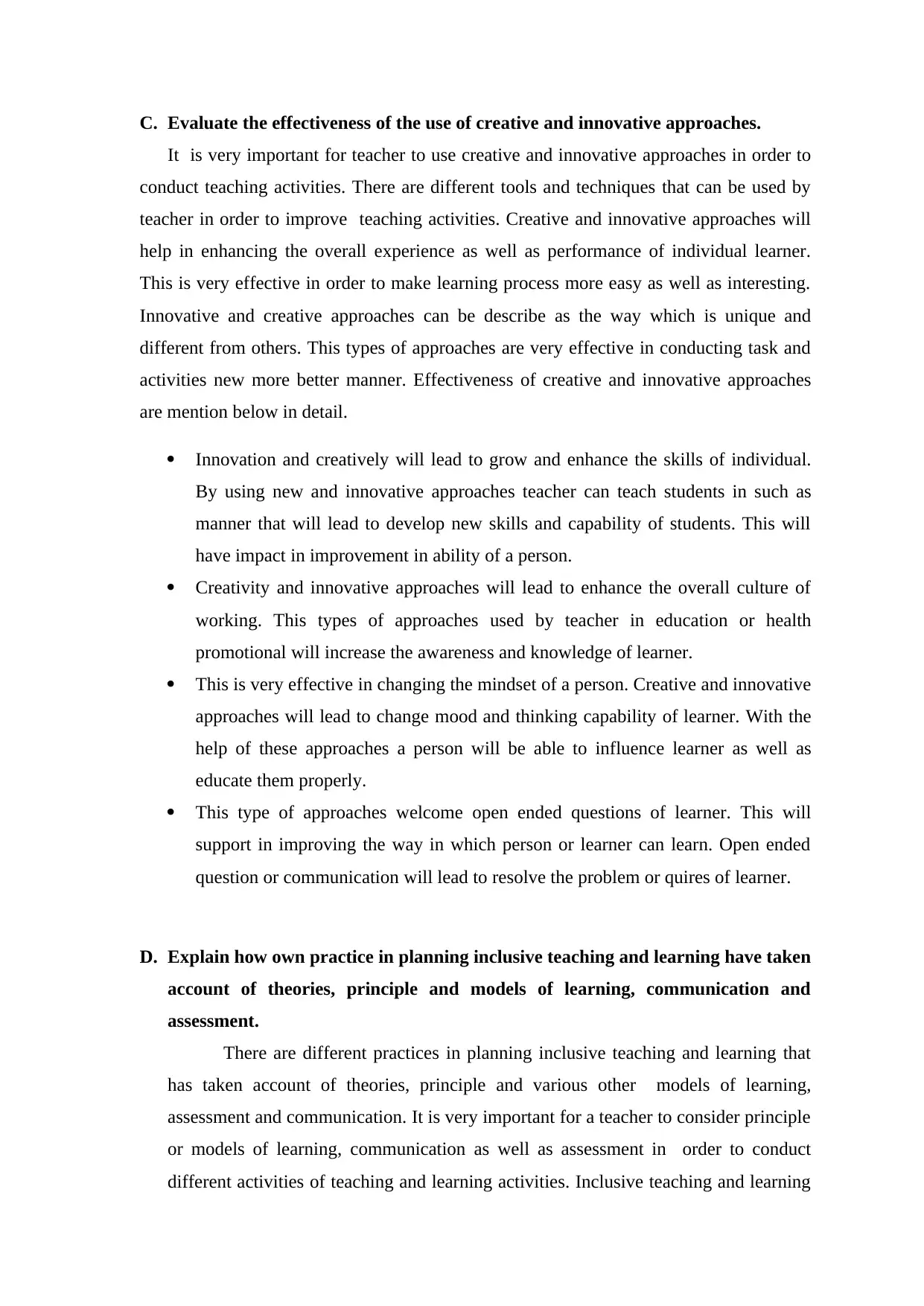
C. Evaluate the effectiveness of the use of creative and innovative approaches.
It is very important for teacher to use creative and innovative approaches in order to
conduct teaching activities. There are different tools and techniques that can be used by
teacher in order to improve teaching activities. Creative and innovative approaches will
help in enhancing the overall experience as well as performance of individual learner.
This is very effective in order to make learning process more easy as well as interesting.
Innovative and creative approaches can be describe as the way which is unique and
different from others. This types of approaches are very effective in conducting task and
activities new more better manner. Effectiveness of creative and innovative approaches
are mention below in detail.
Innovation and creatively will lead to grow and enhance the skills of individual.
By using new and innovative approaches teacher can teach students in such as
manner that will lead to develop new skills and capability of students. This will
have impact in improvement in ability of a person.
Creativity and innovative approaches will lead to enhance the overall culture of
working. This types of approaches used by teacher in education or health
promotional will increase the awareness and knowledge of learner.
This is very effective in changing the mindset of a person. Creative and innovative
approaches will lead to change mood and thinking capability of learner. With the
help of these approaches a person will be able to influence learner as well as
educate them properly.
This type of approaches welcome open ended questions of learner. This will
support in improving the way in which person or learner can learn. Open ended
question or communication will lead to resolve the problem or quires of learner.
D. Explain how own practice in planning inclusive teaching and learning have taken
account of theories, principle and models of learning, communication and
assessment.
There are different practices in planning inclusive teaching and learning that
has taken account of theories, principle and various other models of learning,
assessment and communication. It is very important for a teacher to consider principle
or models of learning, communication as well as assessment in order to conduct
different activities of teaching and learning activities. Inclusive teaching and learning
It is very important for teacher to use creative and innovative approaches in order to
conduct teaching activities. There are different tools and techniques that can be used by
teacher in order to improve teaching activities. Creative and innovative approaches will
help in enhancing the overall experience as well as performance of individual learner.
This is very effective in order to make learning process more easy as well as interesting.
Innovative and creative approaches can be describe as the way which is unique and
different from others. This types of approaches are very effective in conducting task and
activities new more better manner. Effectiveness of creative and innovative approaches
are mention below in detail.
Innovation and creatively will lead to grow and enhance the skills of individual.
By using new and innovative approaches teacher can teach students in such as
manner that will lead to develop new skills and capability of students. This will
have impact in improvement in ability of a person.
Creativity and innovative approaches will lead to enhance the overall culture of
working. This types of approaches used by teacher in education or health
promotional will increase the awareness and knowledge of learner.
This is very effective in changing the mindset of a person. Creative and innovative
approaches will lead to change mood and thinking capability of learner. With the
help of these approaches a person will be able to influence learner as well as
educate them properly.
This type of approaches welcome open ended questions of learner. This will
support in improving the way in which person or learner can learn. Open ended
question or communication will lead to resolve the problem or quires of learner.
D. Explain how own practice in planning inclusive teaching and learning have taken
account of theories, principle and models of learning, communication and
assessment.
There are different practices in planning inclusive teaching and learning that
has taken account of theories, principle and various other models of learning,
assessment and communication. It is very important for a teacher to consider principle
or models of learning, communication as well as assessment in order to conduct
different activities of teaching and learning activities. Inclusive teaching and learning
⊘ This is a preview!⊘
Do you want full access?
Subscribe today to unlock all pages.

Trusted by 1+ million students worldwide
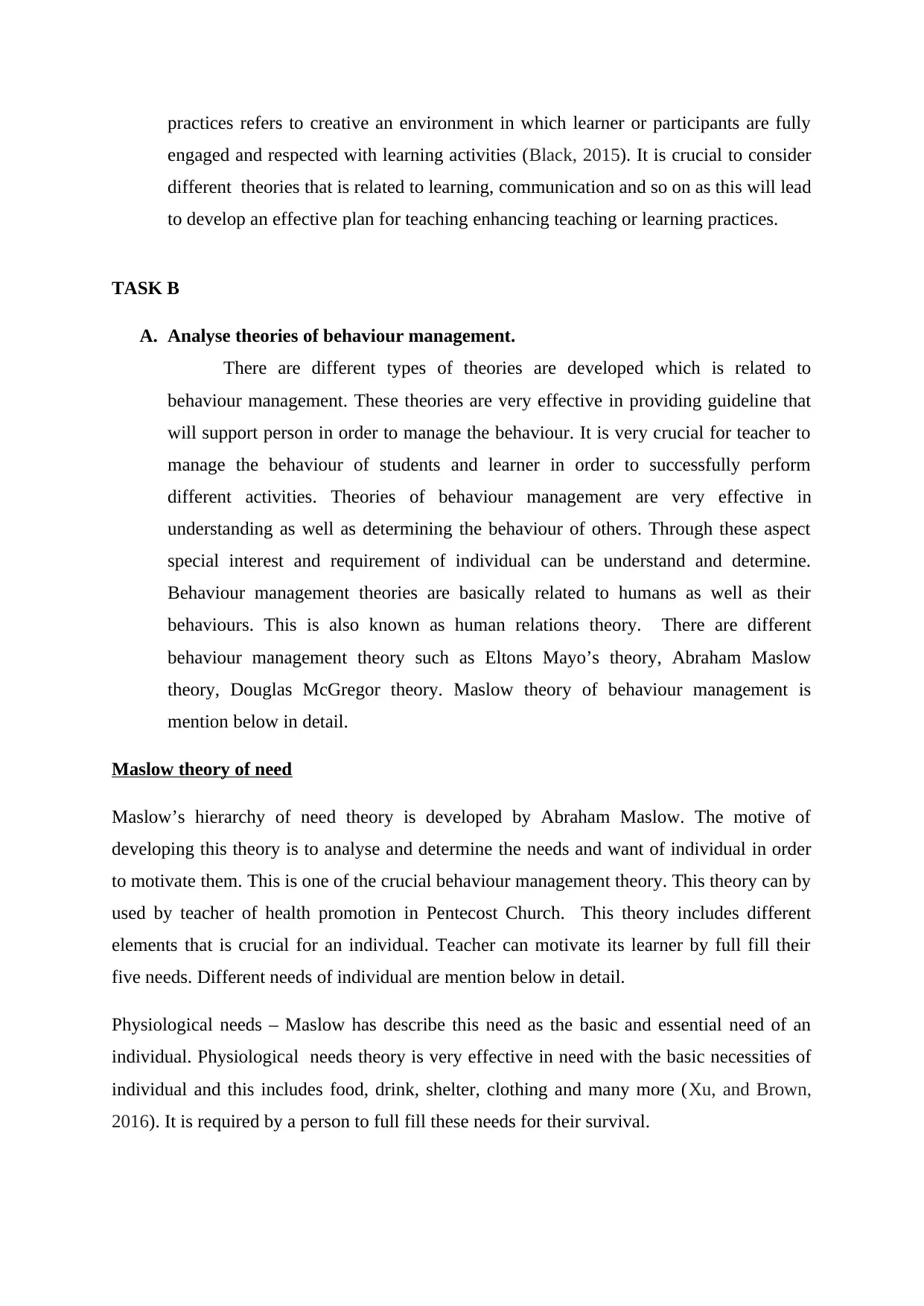
practices refers to creative an environment in which learner or participants are fully
engaged and respected with learning activities (Black, 2015). It is crucial to consider
different theories that is related to learning, communication and so on as this will lead
to develop an effective plan for teaching enhancing teaching or learning practices.
TASK B
A. Analyse theories of behaviour management.
There are different types of theories are developed which is related to
behaviour management. These theories are very effective in providing guideline that
will support person in order to manage the behaviour. It is very crucial for teacher to
manage the behaviour of students and learner in order to successfully perform
different activities. Theories of behaviour management are very effective in
understanding as well as determining the behaviour of others. Through these aspect
special interest and requirement of individual can be understand and determine.
Behaviour management theories are basically related to humans as well as their
behaviours. This is also known as human relations theory. There are different
behaviour management theory such as Eltons Mayo’s theory, Abraham Maslow
theory, Douglas McGregor theory. Maslow theory of behaviour management is
mention below in detail.
Maslow theory of need
Maslow’s hierarchy of need theory is developed by Abraham Maslow. The motive of
developing this theory is to analyse and determine the needs and want of individual in order
to motivate them. This is one of the crucial behaviour management theory. This theory can by
used by teacher of health promotion in Pentecost Church. This theory includes different
elements that is crucial for an individual. Teacher can motivate its learner by full fill their
five needs. Different needs of individual are mention below in detail.
Physiological needs – Maslow has describe this need as the basic and essential need of an
individual. Physiological needs theory is very effective in need with the basic necessities of
individual and this includes food, drink, shelter, clothing and many more (Xu, and Brown,
2016). It is required by a person to full fill these needs for their survival.
engaged and respected with learning activities (Black, 2015). It is crucial to consider
different theories that is related to learning, communication and so on as this will lead
to develop an effective plan for teaching enhancing teaching or learning practices.
TASK B
A. Analyse theories of behaviour management.
There are different types of theories are developed which is related to
behaviour management. These theories are very effective in providing guideline that
will support person in order to manage the behaviour. It is very crucial for teacher to
manage the behaviour of students and learner in order to successfully perform
different activities. Theories of behaviour management are very effective in
understanding as well as determining the behaviour of others. Through these aspect
special interest and requirement of individual can be understand and determine.
Behaviour management theories are basically related to humans as well as their
behaviours. This is also known as human relations theory. There are different
behaviour management theory such as Eltons Mayo’s theory, Abraham Maslow
theory, Douglas McGregor theory. Maslow theory of behaviour management is
mention below in detail.
Maslow theory of need
Maslow’s hierarchy of need theory is developed by Abraham Maslow. The motive of
developing this theory is to analyse and determine the needs and want of individual in order
to motivate them. This is one of the crucial behaviour management theory. This theory can by
used by teacher of health promotion in Pentecost Church. This theory includes different
elements that is crucial for an individual. Teacher can motivate its learner by full fill their
five needs. Different needs of individual are mention below in detail.
Physiological needs – Maslow has describe this need as the basic and essential need of an
individual. Physiological needs theory is very effective in need with the basic necessities of
individual and this includes food, drink, shelter, clothing and many more (Xu, and Brown,
2016). It is required by a person to full fill these needs for their survival.
Paraphrase This Document
Need a fresh take? Get an instant paraphrase of this document with our AI Paraphraser
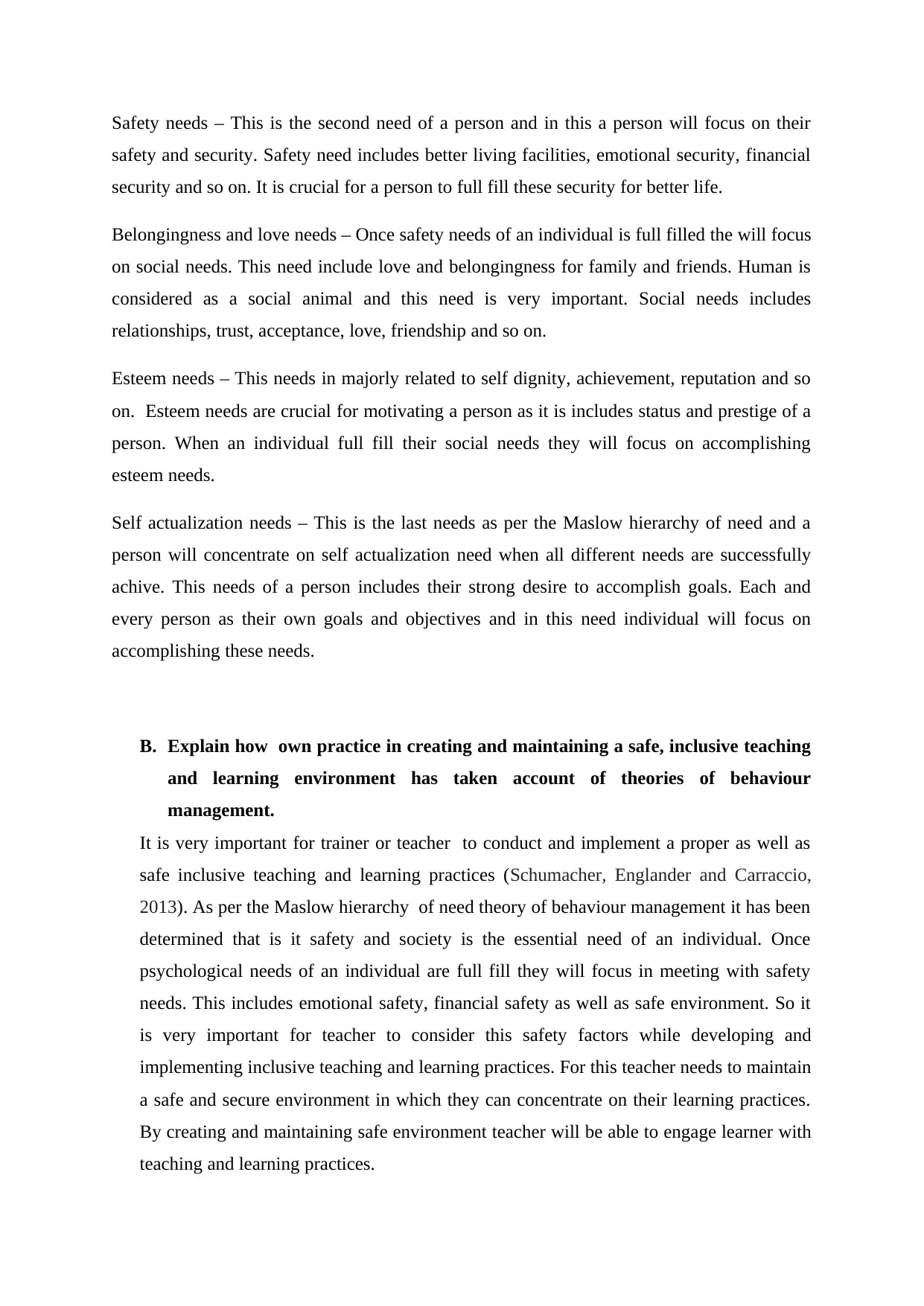
Safety needs – This is the second need of a person and in this a person will focus on their
safety and security. Safety need includes better living facilities, emotional security, financial
security and so on. It is crucial for a person to full fill these security for better life.
Belongingness and love needs – Once safety needs of an individual is full filled the will focus
on social needs. This need include love and belongingness for family and friends. Human is
considered as a social animal and this need is very important. Social needs includes
relationships, trust, acceptance, love, friendship and so on.
Esteem needs – This needs in majorly related to self dignity, achievement, reputation and so
on. Esteem needs are crucial for motivating a person as it is includes status and prestige of a
person. When an individual full fill their social needs they will focus on accomplishing
esteem needs.
Self actualization needs – This is the last needs as per the Maslow hierarchy of need and a
person will concentrate on self actualization need when all different needs are successfully
achive. This needs of a person includes their strong desire to accomplish goals. Each and
every person as their own goals and objectives and in this need individual will focus on
accomplishing these needs.
B. Explain how own practice in creating and maintaining a safe, inclusive teaching
and learning environment has taken account of theories of behaviour
management.
It is very important for trainer or teacher to conduct and implement a proper as well as
safe inclusive teaching and learning practices (Schumacher, Englander and Carraccio,
2013). As per the Maslow hierarchy of need theory of behaviour management it has been
determined that is it safety and society is the essential need of an individual. Once
psychological needs of an individual are full fill they will focus in meeting with safety
needs. This includes emotional safety, financial safety as well as safe environment. So it
is very important for teacher to consider this safety factors while developing and
implementing inclusive teaching and learning practices. For this teacher needs to maintain
a safe and secure environment in which they can concentrate on their learning practices.
By creating and maintaining safe environment teacher will be able to engage learner with
teaching and learning practices.
safety and security. Safety need includes better living facilities, emotional security, financial
security and so on. It is crucial for a person to full fill these security for better life.
Belongingness and love needs – Once safety needs of an individual is full filled the will focus
on social needs. This need include love and belongingness for family and friends. Human is
considered as a social animal and this need is very important. Social needs includes
relationships, trust, acceptance, love, friendship and so on.
Esteem needs – This needs in majorly related to self dignity, achievement, reputation and so
on. Esteem needs are crucial for motivating a person as it is includes status and prestige of a
person. When an individual full fill their social needs they will focus on accomplishing
esteem needs.
Self actualization needs – This is the last needs as per the Maslow hierarchy of need and a
person will concentrate on self actualization need when all different needs are successfully
achive. This needs of a person includes their strong desire to accomplish goals. Each and
every person as their own goals and objectives and in this need individual will focus on
accomplishing these needs.
B. Explain how own practice in creating and maintaining a safe, inclusive teaching
and learning environment has taken account of theories of behaviour
management.
It is very important for trainer or teacher to conduct and implement a proper as well as
safe inclusive teaching and learning practices (Schumacher, Englander and Carraccio,
2013). As per the Maslow hierarchy of need theory of behaviour management it has been
determined that is it safety and society is the essential need of an individual. Once
psychological needs of an individual are full fill they will focus in meeting with safety
needs. This includes emotional safety, financial safety as well as safe environment. So it
is very important for teacher to consider this safety factors while developing and
implementing inclusive teaching and learning practices. For this teacher needs to maintain
a safe and secure environment in which they can concentrate on their learning practices.
By creating and maintaining safe environment teacher will be able to engage learner with
teaching and learning practices.
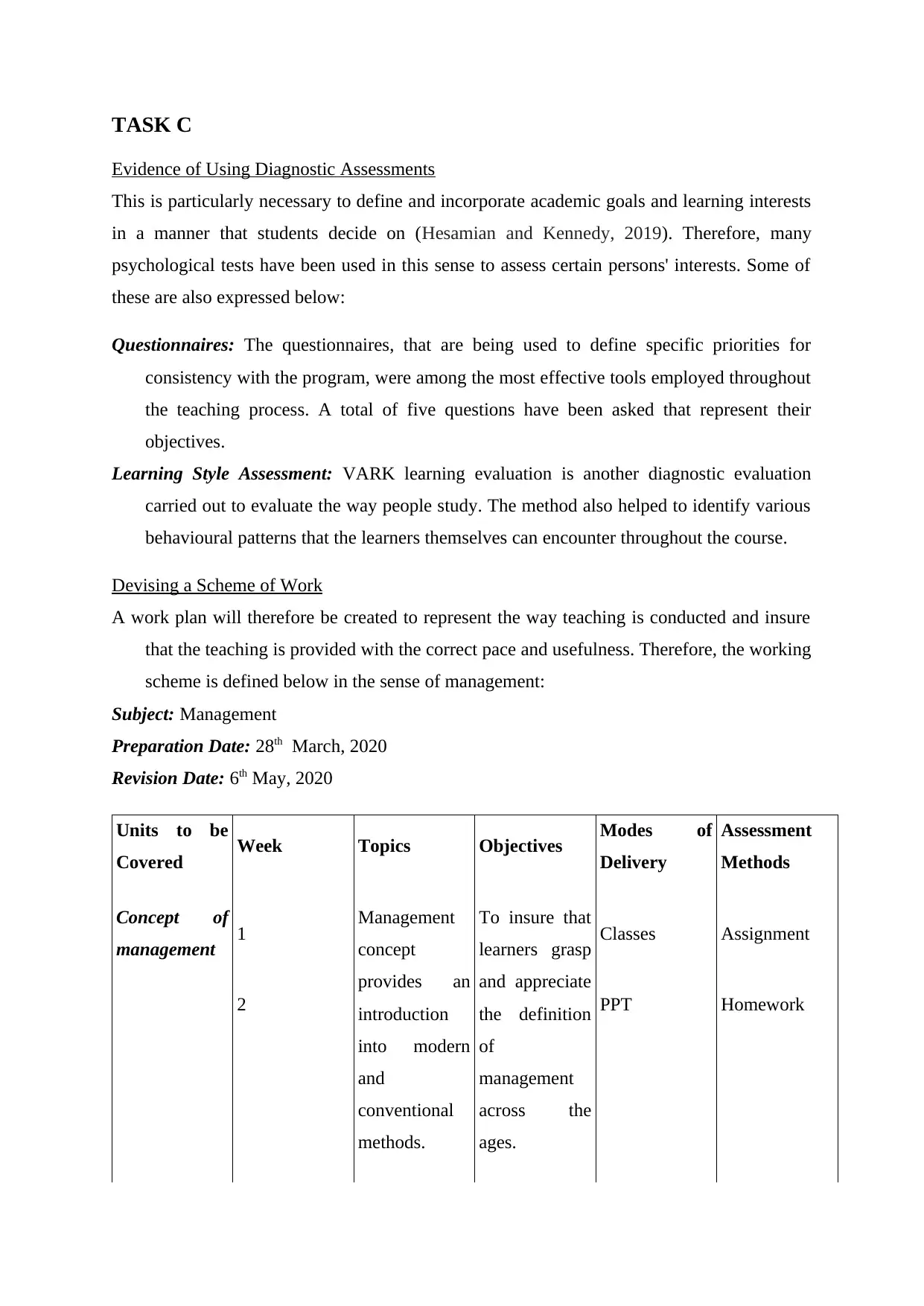
TASK C
Evidence of Using Diagnostic Assessments
This is particularly necessary to define and incorporate academic goals and learning interests
in a manner that students decide on (Hesamian and Kennedy, 2019). Therefore, many
psychological tests have been used in this sense to assess certain persons' interests. Some of
these are also expressed below:
Questionnaires: The questionnaires, that are being used to define specific priorities for
consistency with the program, were among the most effective tools employed throughout
the teaching process. A total of five questions have been asked that represent their
objectives.
Learning Style Assessment: VARK learning evaluation is another diagnostic evaluation
carried out to evaluate the way people study. The method also helped to identify various
behavioural patterns that the learners themselves can encounter throughout the course.
Devising a Scheme of Work
A work plan will therefore be created to represent the way teaching is conducted and insure
that the teaching is provided with the correct pace and usefulness. Therefore, the working
scheme is defined below in the sense of management:
Subject: Management
Preparation Date: 28th March, 2020
Revision Date: 6th May, 2020
Units to be
Covered Week Topics Objectives Modes of
Delivery
Assessment
Methods
Concept of
management 1 Management
concept
provides an
introduction
into modern
and
conventional
methods.
To insure that
learners grasp
and appreciate
the definition
of
management
across the
ages.
Classes Assignment
2 PPT Homework
Evidence of Using Diagnostic Assessments
This is particularly necessary to define and incorporate academic goals and learning interests
in a manner that students decide on (Hesamian and Kennedy, 2019). Therefore, many
psychological tests have been used in this sense to assess certain persons' interests. Some of
these are also expressed below:
Questionnaires: The questionnaires, that are being used to define specific priorities for
consistency with the program, were among the most effective tools employed throughout
the teaching process. A total of five questions have been asked that represent their
objectives.
Learning Style Assessment: VARK learning evaluation is another diagnostic evaluation
carried out to evaluate the way people study. The method also helped to identify various
behavioural patterns that the learners themselves can encounter throughout the course.
Devising a Scheme of Work
A work plan will therefore be created to represent the way teaching is conducted and insure
that the teaching is provided with the correct pace and usefulness. Therefore, the working
scheme is defined below in the sense of management:
Subject: Management
Preparation Date: 28th March, 2020
Revision Date: 6th May, 2020
Units to be
Covered Week Topics Objectives Modes of
Delivery
Assessment
Methods
Concept of
management 1 Management
concept
provides an
introduction
into modern
and
conventional
methods.
To insure that
learners grasp
and appreciate
the definition
of
management
across the
ages.
Classes Assignment
2 PPT Homework
⊘ This is a preview!⊘
Do you want full access?
Subscribe today to unlock all pages.

Trusted by 1+ million students worldwide
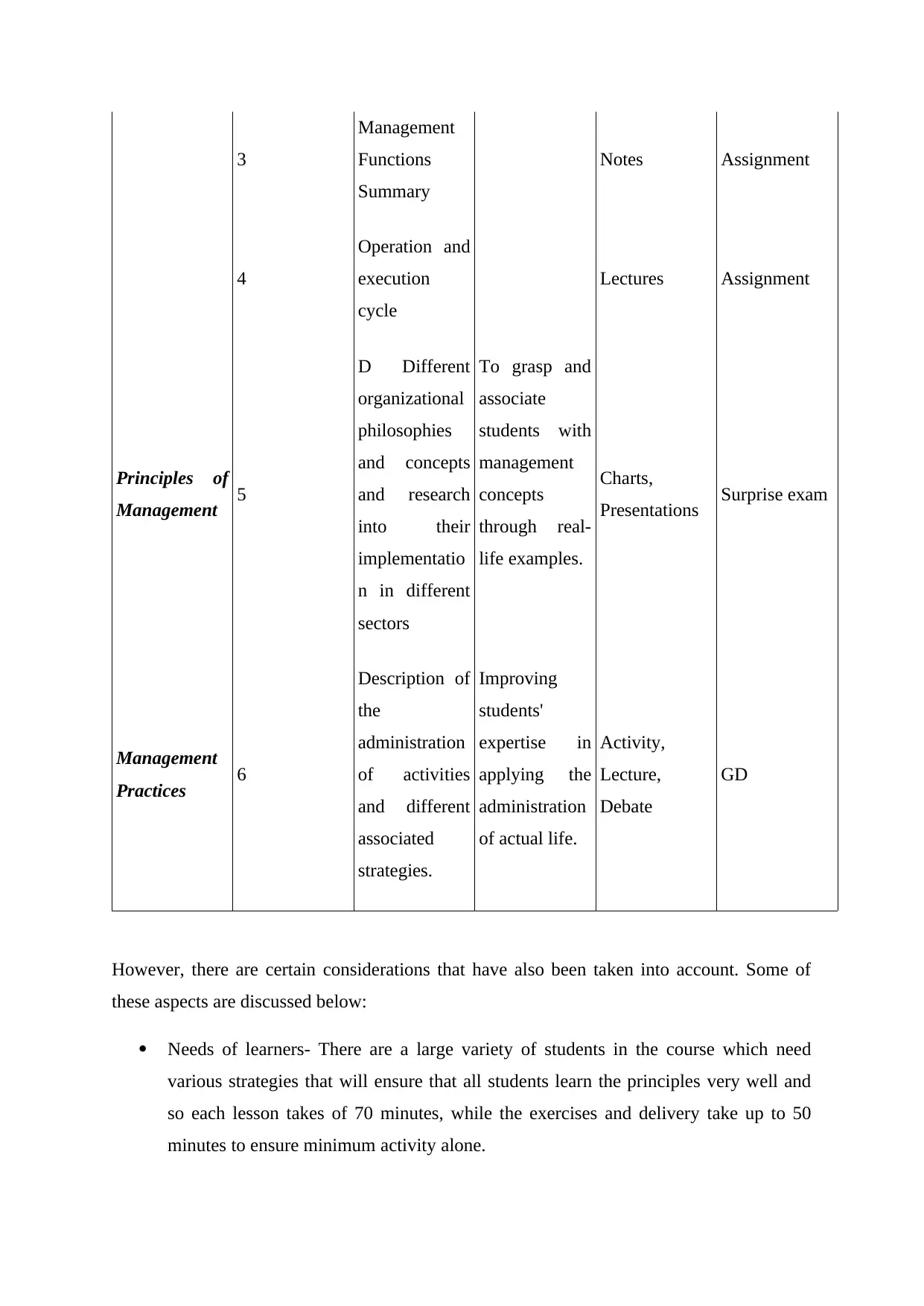
3
Management
Functions
Summary
Notes Assignment
4
Operation and
execution
cycle
Lectures Assignment
Principles of
Management 5
D Different
organizational
philosophies
and concepts
and research
into their
implementatio
n in different
sectors
To grasp and
associate
students with
management
concepts
through real-
life examples.
Charts,
Presentations Surprise exam
Management
Practices 6
Description of
the
administration
of activities
and different
associated
strategies.
Improving
students'
expertise in
applying the
administration
of actual life.
Activity,
Lecture,
Debate
GD
However, there are certain considerations that have also been taken into account. Some of
these aspects are discussed below:
Needs of learners- There are a large variety of students in the course which need
various strategies that will ensure that all students learn the principles very well and
so each lesson takes of 70 minutes, while the exercises and delivery take up to 50
minutes to ensure minimum activity alone.
Management
Functions
Summary
Notes Assignment
4
Operation and
execution
cycle
Lectures Assignment
Principles of
Management 5
D Different
organizational
philosophies
and concepts
and research
into their
implementatio
n in different
sectors
To grasp and
associate
students with
management
concepts
through real-
life examples.
Charts,
Presentations Surprise exam
Management
Practices 6
Description of
the
administration
of activities
and different
associated
strategies.
Improving
students'
expertise in
applying the
administration
of actual life.
Activity,
Lecture,
Debate
GD
However, there are certain considerations that have also been taken into account. Some of
these aspects are discussed below:
Needs of learners- There are a large variety of students in the course which need
various strategies that will ensure that all students learn the principles very well and
so each lesson takes of 70 minutes, while the exercises and delivery take up to 50
minutes to ensure minimum activity alone.
Paraphrase This Document
Need a fresh take? Get an instant paraphrase of this document with our AI Paraphraser
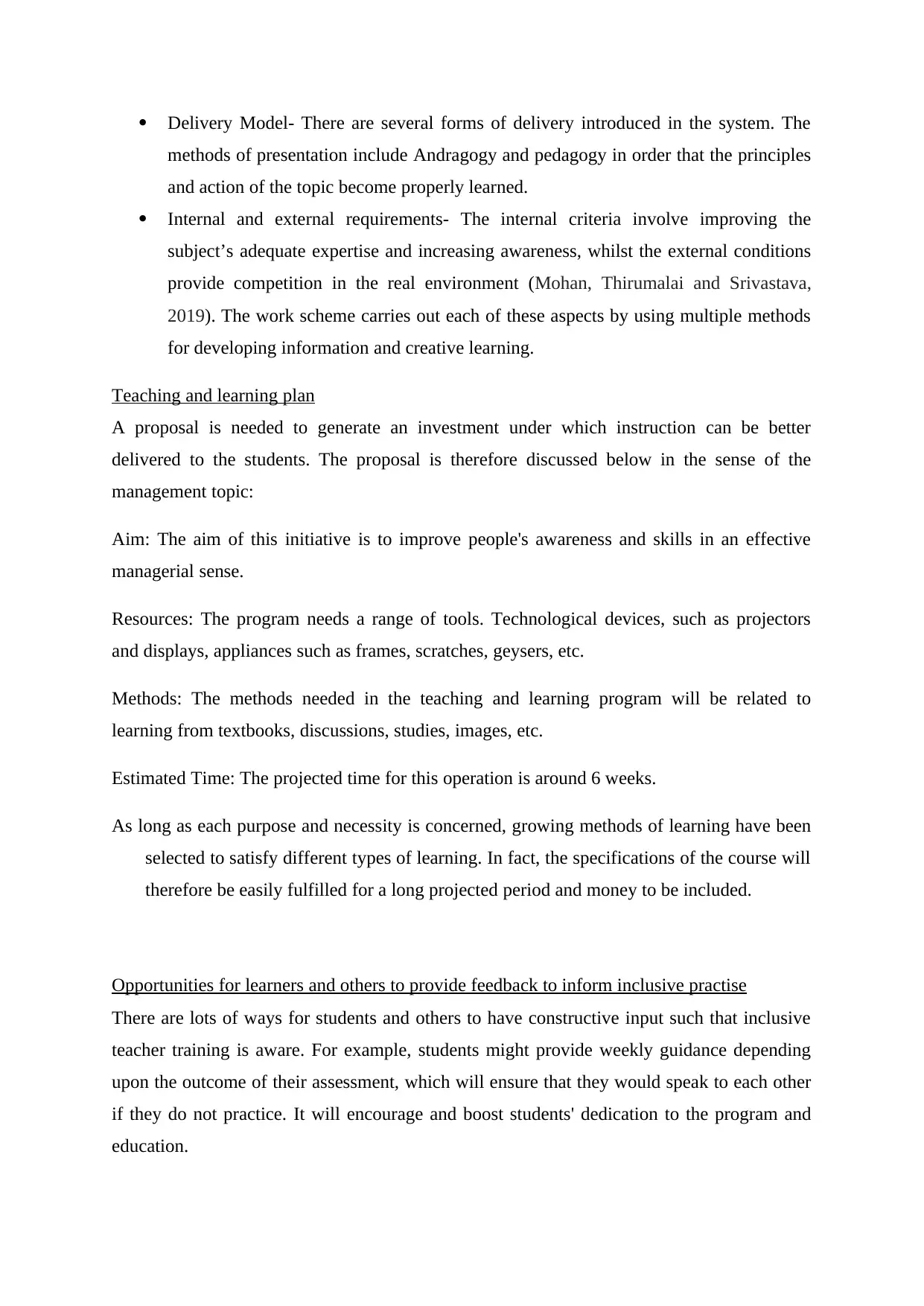
Delivery Model- There are several forms of delivery introduced in the system. The
methods of presentation include Andragogy and pedagogy in order that the principles
and action of the topic become properly learned.
Internal and external requirements- The internal criteria involve improving the
subject’s adequate expertise and increasing awareness, whilst the external conditions
provide competition in the real environment (Mohan, Thirumalai and Srivastava,
2019). The work scheme carries out each of these aspects by using multiple methods
for developing information and creative learning.
Teaching and learning plan
A proposal is needed to generate an investment under which instruction can be better
delivered to the students. The proposal is therefore discussed below in the sense of the
management topic:
Aim: The aim of this initiative is to improve people's awareness and skills in an effective
managerial sense.
Resources: The program needs a range of tools. Technological devices, such as projectors
and displays, appliances such as frames, scratches, geysers, etc.
Methods: The methods needed in the teaching and learning program will be related to
learning from textbooks, discussions, studies, images, etc.
Estimated Time: The projected time for this operation is around 6 weeks.
As long as each purpose and necessity is concerned, growing methods of learning have been
selected to satisfy different types of learning. In fact, the specifications of the course will
therefore be easily fulfilled for a long projected period and money to be included.
Opportunities for learners and others to provide feedback to inform inclusive practise
There are lots of ways for students and others to have constructive input such that inclusive
teacher training is aware. For example, students might provide weekly guidance depending
upon the outcome of their assessment, which will ensure that they would speak to each other
if they do not practice. It will encourage and boost students' dedication to the program and
education.
methods of presentation include Andragogy and pedagogy in order that the principles
and action of the topic become properly learned.
Internal and external requirements- The internal criteria involve improving the
subject’s adequate expertise and increasing awareness, whilst the external conditions
provide competition in the real environment (Mohan, Thirumalai and Srivastava,
2019). The work scheme carries out each of these aspects by using multiple methods
for developing information and creative learning.
Teaching and learning plan
A proposal is needed to generate an investment under which instruction can be better
delivered to the students. The proposal is therefore discussed below in the sense of the
management topic:
Aim: The aim of this initiative is to improve people's awareness and skills in an effective
managerial sense.
Resources: The program needs a range of tools. Technological devices, such as projectors
and displays, appliances such as frames, scratches, geysers, etc.
Methods: The methods needed in the teaching and learning program will be related to
learning from textbooks, discussions, studies, images, etc.
Estimated Time: The projected time for this operation is around 6 weeks.
As long as each purpose and necessity is concerned, growing methods of learning have been
selected to satisfy different types of learning. In fact, the specifications of the course will
therefore be easily fulfilled for a long projected period and money to be included.
Opportunities for learners and others to provide feedback to inform inclusive practise
There are lots of ways for students and others to have constructive input such that inclusive
teacher training is aware. For example, students might provide weekly guidance depending
upon the outcome of their assessment, which will ensure that they would speak to each other
if they do not practice. It will encourage and boost students' dedication to the program and
education.
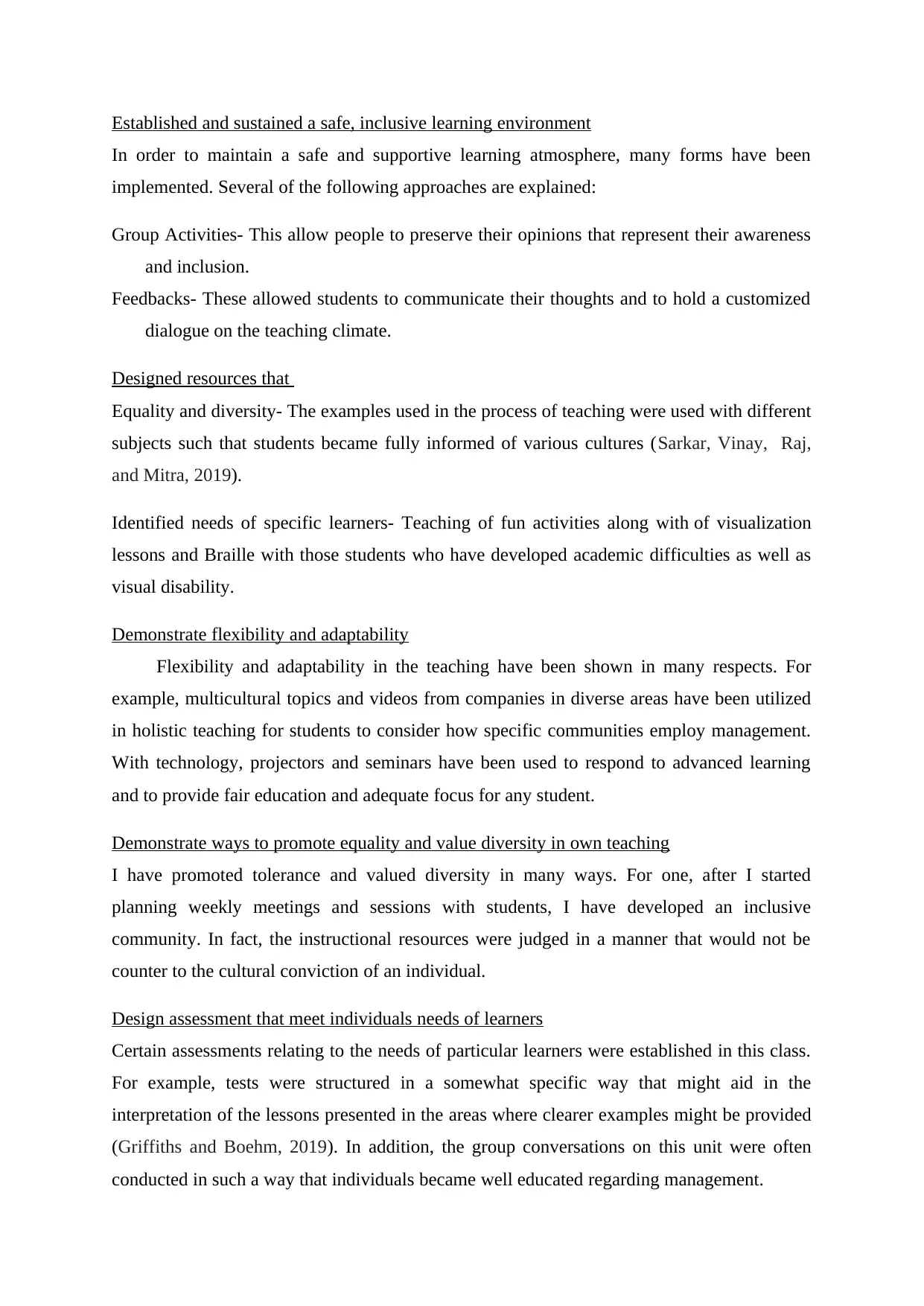
Established and sustained a safe, inclusive learning environment
In order to maintain a safe and supportive learning atmosphere, many forms have been
implemented. Several of the following approaches are explained:
Group Activities- This allow people to preserve their opinions that represent their awareness
and inclusion.
Feedbacks- These allowed students to communicate their thoughts and to hold a customized
dialogue on the teaching climate.
Designed resources that
Equality and diversity- The examples used in the process of teaching were used with different
subjects such that students became fully informed of various cultures (Sarkar, Vinay, Raj,
and Mitra, 2019).
Identified needs of specific learners- Teaching of fun activities along with of visualization
lessons and Braille with those students who have developed academic difficulties as well as
visual disability.
Demonstrate flexibility and adaptability
Flexibility and adaptability in the teaching have been shown in many respects. For
example, multicultural topics and videos from companies in diverse areas have been utilized
in holistic teaching for students to consider how specific communities employ management.
With technology, projectors and seminars have been used to respond to advanced learning
and to provide fair education and adequate focus for any student.
Demonstrate ways to promote equality and value diversity in own teaching
I have promoted tolerance and valued diversity in many ways. For one, after I started
planning weekly meetings and sessions with students, I have developed an inclusive
community. In fact, the instructional resources were judged in a manner that would not be
counter to the cultural conviction of an individual.
Design assessment that meet individuals needs of learners
Certain assessments relating to the needs of particular learners were established in this class.
For example, tests were structured in a somewhat specific way that might aid in the
interpretation of the lessons presented in the areas where clearer examples might be provided
(Griffiths and Boehm, 2019). In addition, the group conversations on this unit were often
conducted in such a way that individuals became well educated regarding management.
In order to maintain a safe and supportive learning atmosphere, many forms have been
implemented. Several of the following approaches are explained:
Group Activities- This allow people to preserve their opinions that represent their awareness
and inclusion.
Feedbacks- These allowed students to communicate their thoughts and to hold a customized
dialogue on the teaching climate.
Designed resources that
Equality and diversity- The examples used in the process of teaching were used with different
subjects such that students became fully informed of various cultures (Sarkar, Vinay, Raj,
and Mitra, 2019).
Identified needs of specific learners- Teaching of fun activities along with of visualization
lessons and Braille with those students who have developed academic difficulties as well as
visual disability.
Demonstrate flexibility and adaptability
Flexibility and adaptability in the teaching have been shown in many respects. For
example, multicultural topics and videos from companies in diverse areas have been utilized
in holistic teaching for students to consider how specific communities employ management.
With technology, projectors and seminars have been used to respond to advanced learning
and to provide fair education and adequate focus for any student.
Demonstrate ways to promote equality and value diversity in own teaching
I have promoted tolerance and valued diversity in many ways. For one, after I started
planning weekly meetings and sessions with students, I have developed an inclusive
community. In fact, the instructional resources were judged in a manner that would not be
counter to the cultural conviction of an individual.
Design assessment that meet individuals needs of learners
Certain assessments relating to the needs of particular learners were established in this class.
For example, tests were structured in a somewhat specific way that might aid in the
interpretation of the lessons presented in the areas where clearer examples might be provided
(Griffiths and Boehm, 2019). In addition, the group conversations on this unit were often
conducted in such a way that individuals became well educated regarding management.
⊘ This is a preview!⊘
Do you want full access?
Subscribe today to unlock all pages.

Trusted by 1+ million students worldwide
1 out of 18
Related Documents
Your All-in-One AI-Powered Toolkit for Academic Success.
+13062052269
info@desklib.com
Available 24*7 on WhatsApp / Email
![[object Object]](/_next/static/media/star-bottom.7253800d.svg)
Unlock your academic potential
Copyright © 2020–2025 A2Z Services. All Rights Reserved. Developed and managed by ZUCOL.




